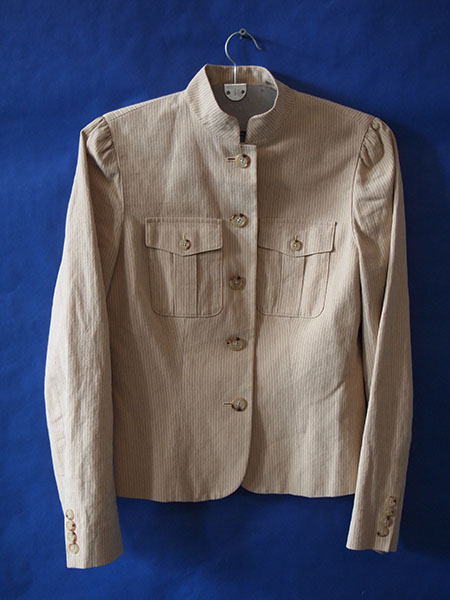![]() body | color | collections | commodity | cube | document | fabric | fetish | gender | glass | home | identity | living | machine | metal | minimal | mobility | narrative | olfactory | organic |
body | color | collections | commodity | cube | document | fabric | fetish | gender | glass | home | identity | living | machine | metal | minimal | mobility | narrative | olfactory | organic |
![]() pain | paper | plastic | plugs | power | protective | rectangular | ritual | round | sound | souvenir | spiritual | style | text-based | time | tool | touch | uniform | value | visual | warm | wood
pain | paper | plastic | plugs | power | protective | rectangular | ritual | round | sound | souvenir | spiritual | style | text-based | time | tool | touch | uniform | value | visual | warm | wood
| Clothing: Beig Button Up Jacket with Thin Brown Stripes | |||
Narrative: Lauren by Ralph Lauren I purchaed this from a Goodwill Thrift Store outside of Raleigh, NC. In a recent study commissioned by Greenpeace International, several major clothing brands including Ralph Lauren were found guilty of using nonylphenol ethoxylates (NPEs) in the manufacturing process. This chemical breaks down into toxic nonylphenol (NP), which has hormone-disrupting properties that persist over time and can be hazardous even at low levels. Cellulose acetate fiber is one of the earliest synthetic fibers and is based on cotton or tree pulp cellulose ("biopolymers"). These "cellulosic fibers" have been replaced in many applications by cheaper petro-based fibers (nylon and polyester) in recent decades. The Federal Trade Commission definition for acetate fiber is "A manufactured fiber in which the fiber-forming substance is cellulose acetate. Where not less than 92 percent of the hydroxyl groups are acetylated, the term triacetate may be used as a generic description of the fiber." Acetate is derived from cellulose by deconstructing wood pulp into a purified fluffy white cellulose. In a recent study commissioned by Greenpeace International, several major clothing brands including Ralph Lauren were found guilty of using nonylphenol ethoxylates (NPEs) in the manufacturing process. This chemical breaks down into toxic nonylphenol (NP), which has hormone-disrupting properties that persist over time and can be hazardous even at low levels.
|
 |
||
![]()
